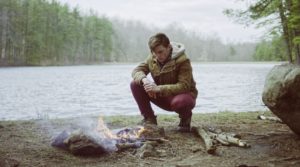When I really started traveling at the age of twenty—leaving my hometown in western New York to drive to Washington state, for a new job in an outdoor leadership program—I only looked at the experience in one dimension. I saw it as simply a physical experience of going from one point to another. I was starting a job and I needed to get there.
There were things happening below the surface, though. I was fueled by the adventure of driving cross country for the first time and “not knowing anyone past Ohio,” while I also felt a pit in my stomach, knowing I had little money for anything except gas, dollar Whoppers, and maybe a cheap “no tell motel” along the way. There was an undercurrent of uncertainty, and as I made the trip, I had an inkling I was changing and growing. However, I didn’t know how to articulate it.
As I continued to travel the world, exploring Russia, Europe, Mexico, and Central and South America, I would read books with the hope of better understanding the deeper experience of traveling I was having. Works from Milliman, Neihardt, Joyce, Dostoyevsky, and Twain helped in this but they didn’t help me understand how the experience of travel was affecting me from within.
What finally did, almost fifteen years into my travels, was discovering Joseph Campbell’s work regarding the “Hero’s Journey.” It was at this time that I began to realize the many dimensions of travel and how those experiences made me what I was then and am now.
The intent of this blog is not to take a deep dive into Joseph Campbell’s work—volumes have been written about it. But I’d like to share my experience and interpretation of the Hero’s Journey, as it began for me at age twenty, with the hope you might then reflect on your own life experiences in the context of Campbell’s Hero’s Journey. Perhaps explore Campbell’s work for yourself.
First, a few words about the Hero’s Journey. Most of us are familiar with the basic parts or “acts” this journey includes, even if we don’t realize it. We see them play out in our favorite movies or stories, like “Braveheart,” “Cinderella,” Good Fellas,” and “The Notebook.” At a high level, these parts or acts can be put into four stages: the separation, the descent, the ordeal, and the return.
Once I looked back on my own first journey across the US, I could see these larger stages (along with smaller sub-stages) in my own adventure. As I began to “answer the call” I felt to travel the world and leave my hometown, I had to leave what Campbell would call “the known world” and venture out into the “unknown world.” This became “the separation” away from the safety of my hometown. Truth be told, this separation was not glamorous. I did not step gallantly forward with my chest out and eyes fixed on the horizon. I was extremely hungover, and my best friends literally had to pull me out of my apartment, beat me into my car, and threaten me with more violence if I came back. I cried the first forty plus miles heading west. The separation had taken place.
The further west I ventured the more I moved into my “descent” where the “transformation” began to take place. Being on the road is a great place for one to take inventory of our true selves. Some road warriors even talk about “white line fever,” when the white line on the right side of the road will kind of hypnotize you into a deep state of self-reflection. Small shifts begin to take place in the descent. For me, one was the realization that I’d left the known and now I had to make it on my own; it was up to me how the whole thing worked out. When these small shifts begin to add up, large changes manifest (whether you know it at the time or not).
From there, I moved into “the ordeal,” where some of the changes I’d undergone supported me through overcoming challenges and adversity. In movies and stories the ordeal is plain for all to see. However, in real life, especially when you are living from one ordeal to the next like I was, it’s sometimes less defined. After the challenges of driving across America, I then had to learn a new kind of job, overcome being homesick and insanely poor, support my student’s development, and keep them safe on eighteen-day Winter Expeditions. I felt a form of constant strain. Thankfully, I had great people to work with through these times and support me on overcoming the various forms of adversity. In Campbell’s terms they are the “sages.”
Then, with “the return,” I headed back to New York. Returning to where I’d started. But I wasn’t the same person I was when I left. And when I returned, I shared what I’d learned while away. I knew I had discovered some truths: That I am capable of safely guiding adolescents in the outdoors for many days and even in the winter. What it means to be “mission oriented.” And most importantly, that once you “answer the call” or break away from the safety of what is known and step into the unknown, you can go anywhere. This is what I shared when it was appropriate with the hometown folk.
During my travels, I had moved through the framework of Campbell’s Hero’s Journey, but I wasn’t aware of it at the time. I wish I knew then what I know now.
When we understand the common patterns of the Hero’s Journey—which appear all around us in the stories we hear from others, movies, books, and our own lives—we gain a valuable tool for navigating our path. When we recognize these patterns in our own lives, our experience takes on richer meaning. We can look back and recall our past journeys and the truths we discovered, and also better understand where we are now. These patterns and stages are a circular experience; we all take a number of journeys in our lifetime. And when we sense where we are in the Hero’s Journey, these patterns can help guide us. For example, when we feel or experience “the call to action” and see it as such, we may be keener to accept it because we know that transformation follows.
Understanding these patterns also helps us relate to other people’s stories. We can see what they did well or what they could have done differently, and if we are faced with similar adversity we can make the best choices for ourselves. It’s also important to pay attention to others’ journeys so you can support or play a positive “role” in helping them. It’s a form of giving back and good karma.
The ups, downs, and lessons of a well-lived life are meant to be shared with others so that we as a civilization can help each other to become better together. And Joseph Campbell’s work helps connect us.
I believe the Hero’s Journey resonates with many people and cultures because it echoes universal truths and helps us experience the many dimensions of this amazing journey called life. We are all struggling to “answer the call” and complete or stay the course of our own journey and adventures. In order to stay the course and develop as individuals we must experience trials and tribulations—they help us develop spiritually, psychologically, and even physically. It’s in this series of struggles that we begin to better understand ourselves and the world.
I encourage you to read more about (or revisit) Joseph Campbell’s Hero’s Journey for yourself. I also suggest asking, where are you on your journey? What patterns do you see looking back on your life? Who was been a major “sage”, “mentor”, or coach for your journeys? Or maybe you need a coach to help you through your journey? And how can you now support someone else on their journey?




